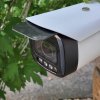A couple tips regarding adding more long pulls in a tight underground conduit. My 1 inch conduit already had three direct burial ethernet cables. Adding two in there was going to be tight. Adding to the fun isa total of 270 degrees of turns in the conduit. Recall that 360 degrees is basically unpullable.
1. Pull lube is your friend, but my old way of adding it a bit at a time into the conduit opening was inefficient and not always continually coating.
Solution was to do the new pulls through a funnel. I keep the funnel 1/3 full of lube. As lines and cables went through the funnel, they naturally got well coated.
2. Because I was unsure of the existing pull line's condition after 7 years in the ground, I didn't want to stress it with a new cable. First pull was a fresh pull line. That had the advantage of loading the old line the least possible AND pre-lubing the entire pathway as the new line traveled the entire 160 foot distance.
3. Pulled ONE new cable at a time instead of getting greedy and attempting two at once. This used up a lot more pull line with each cable pull, but a bottle of pull line is cheap compared to getting two cables jammed half-way. One 500 foot bottle of pull line and two bottles of pull gel later, both cables were pulled through.
4. The amount of force needed exceeds what I can do pulling up on a cable. So, I put a pulley on a post above the destination post. That me me pull down with my weight - much easier than being up on a ladder pulling up with all my might.
5. A foot long piece of wood was essential in getting a good grip on the slippery pull line. Wrap the line a few times around your wood piece and use the wood as a handle as you pull. Unwrap and reposition after each stroke.
BTW, make sure your funnel tip is the right size. It must pass the cable, but not be so large that gel just falls through.







